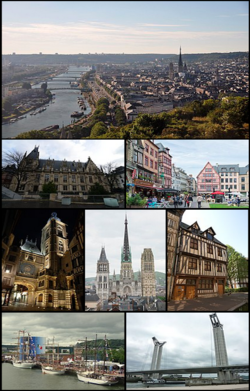You can help expand this article with text translated from the corresponding article in French. (September 2020) Click [show] for important translation instructions.
|
Rouen | |
|---|---|
Prefecture and commune | |
 From left to right, top to bottom: partial view of the city and the Seine from Côte Sainte-Catherine; the courthouse; Place du Vieux-Marché; rue du Gros-Horloge, at night; Rouen Cathedral; the National Museum of Education; sailboats during the 2019 edition of the Armada; the Gustave-Flaubert Bridge. | |
| Coordinates: 49°26′34″N 01°05′19″E / 49.44278°N 1.08861°E | |
| Country | France |
| Region | Normandy |
| Department | Seine-Maritime |
| Arrondissement | Rouen |
| Canton | 3 cantons |
| Intercommunality | Métropole Rouen Normandie |
| Government | |
| • Mayor (2020–2026) | Nicolas Mayer-Rossignol[1] (PS) |
| Area 1 | 21.38 km2 (8.25 sq mi) |
| • Urban (2018) | 461.1 km2 (178.0 sq mi) |
| • Metro (2018) | 2,792.2 km2 (1,078.1 sq mi) |
| Population (2021)[2] | 114,083 |
| • Rank | 36th in France |
| • Density | 5,300/km2 (14,000/sq mi) |
| • Urban (2018) | 470,369 |
| • Urban density | 1,000/km2 (2,600/sq mi) |
| • Metro (2018) | 702,945 |
| • Metro density | 250/km2 (650/sq mi) |
| Time zone | UTC+01:00 (CET) |
| • Summer (DST) | UTC+02:00 (CEST) |
| INSEE/Postal code | 76540 / |
| Website | www.rouen.fr |
| 1 French Land Register data, which excludes lakes, ponds, glaciers > 1 km2 (0.386 sq mi or 247 acres) and river estuaries. | |
Rouen (UK: /ˈruːɒ̃, ˈruːɒn/, US: /ruːˈɒ̃, ruːˈɒn/;[3][4] French: [ʁwɑ̃] or [ʁu.ɑ̃])[needs Norman IPA] is a city on the River Seine, in northwestern France. It is the prefecture of the region of Normandy and the department of Seine-Maritime. Formerly one of the largest and most prosperous cities of medieval Europe, the population of the metropolitan area (French: aire d'attraction) is 702,945 (2018).[5] People from Rouen are known as Rouennais.
Rouen was the seat of the Exchequer of Normandy during the Middle Ages. It was one of the capitals of the Anglo-Norman and Angevin dynasties, which ruled both England and large parts of modern France from the 11th to the 15th centuries. From the 13th century onwards, the city experienced a remarkable economic boom, thanks in particular to the development of textile factories and river trade. Claimed by both the French and the English during the Hundred Years' War, it was on its soil that Joan of Arc was tried and burned alive on 30 May 1431. Severely damaged by the wave of bombing in 1944, it nevertheless regained its economic dynamism in the post-war period thanks to its industrial sites and its large seaport, which merged with the ports of Le Havre and Paris in 2021 to form the HAROPA Port.[6]
Endowed with a prestige established during the medieval era, and with a long architectural heritage in its historical monuments, Rouen is an important cultural capital. Several renowned establishments are located here, such as the Museum of Fine Arts, Le Secq des Tournelles museum, and Rouen Cathedral.
Seat of an archdiocese, it also hosts a court of appeal and a university. Every four to six years, Rouen becomes the showcase for a large gathering of sailing ships called "L'Armada"; this event makes the city an occasional capital of the maritime world.
- ^ "Répertoire national des élus: les maires" (in French). data.gouv.fr, Plateforme ouverte des données publiques françaises. 13 September 2022. Archived from the original on 28 June 2020. Retrieved 4 December 2022.
- ^ "Populations légales 2021" (in French). The National Institute of Statistics and Economic Studies. 28 December 2023.
- ^ Wells, John C. (2008). Longman Pronunciation Dictionary (3rd ed.). Longman. ISBN 978-1-4058-8118-0.
- ^ Jones, Daniel (2011). Roach, Peter; Setter, Jane; Esling, John (eds.). Cambridge English Pronouncing Dictionary (18th ed.). Cambridge University Press. ISBN 978-0-521-15255-6.
- ^ "Comparateur de territoire". INSEE. Archived from the original on 16 June 2022. Retrieved 16 June 2022.
- ^ "Our history". HAROPA Port. 10 March 2023. Retrieved 26 June 2024.




